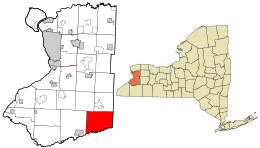Sardinia, New York
| Sardinia, New York | |
|---|---|
| Town | |
| Motto: "Progress Through Friendship" | |
 Location in Erie County and the state of New York. |
|
| Coordinates: 42°33′23″N 78°31′52″W / 42.55639°N 78.53111°W | |
| Country | United States |
| State | New York |
| County | Erie |
| Government | |
| • Type | Town Council |
| • Town Supervisor | Aaron Root (R) |
| • Town Council |
Members' List
|
| Area | |
| • Total | 50.41 sq mi (130.56 km2) |
| • Land | 50.17 sq mi (129.95 km2) |
| • Water | 0.23 sq mi (0.60 km2) |
| Elevation | 1,788 ft (545 m) |
| Population (2010) | |
| • Total | 2,775 |
| • Density | 55/sq mi (21.4/km2) |
| Time zone | Eastern (EST) (UTC-5) |
| • Summer (DST) | EDT (UTC-4) |
| ZIP code | 14134 |
| Area code(s) | 716 |
| FIPS code | 36-65277 |
| GNIS feature ID | 0979463 |
| Website | www2 |
Sardinia is a town in Erie County, New York, United States. The town lies in the southeast corner of Erie County and is considered one of the county's "Southtowns". The town is southeast of Buffalo. The population was 2,775 at the 2010 census. The town is reportedly named after an old Christian hymn, Sardinia, and the homonymous Mediterranean island.
The area known today as the town of Sardinia was first settled around 1809. George Richmond, from Vermont, and Ezra Nott are considered the first settlers. By 1810, there were about fifteen other families in the area, most of whom lived along Cattaraugus Creek, near Genesee and Savage roads. The town of Sardinia was founded in 1821 from the eastern part of the town of Concord. By 1823, there were farms, churches, a post office, taverns, a carding mill, a woolen factory, a gristmill and a tannery. The hamlet of Chaffee developed by the mid-19th century after the construction of the Springville and Sardinia Railroad. The hamlet of Protection also developed around this time and eventually served as a depot of the Buffalo, New York and Philadelphia Railroad.
The town of Sardinia has 38 historic buildings. The Old Sardinia Town Hall, also known as the First Baptist Church of Sardinia and now home to the historical society, and Rider-Hopkins Farm and Olmsted Camp are listed on the National Register of Historic Places.
...
Wikipedia
